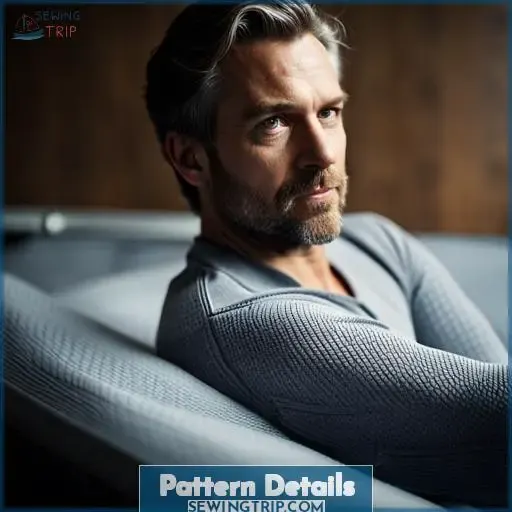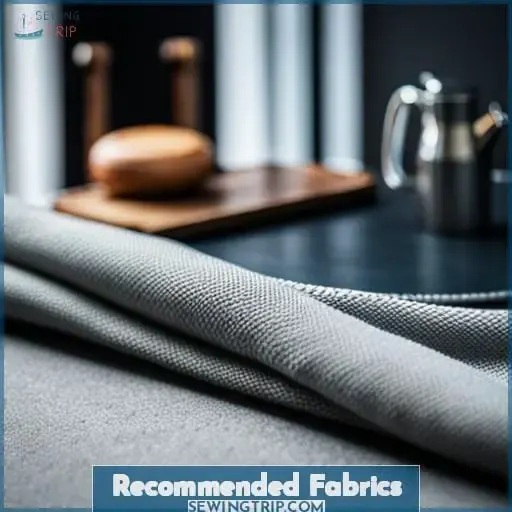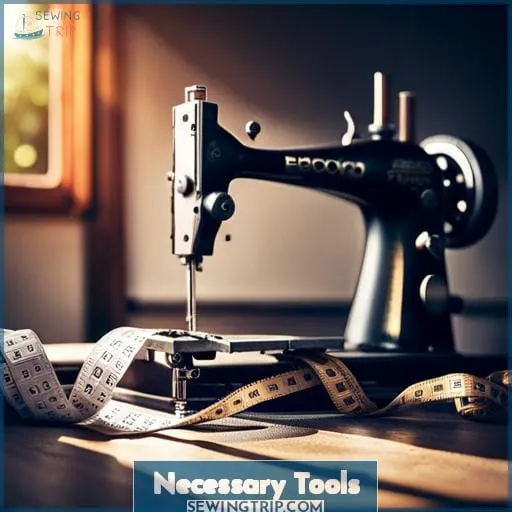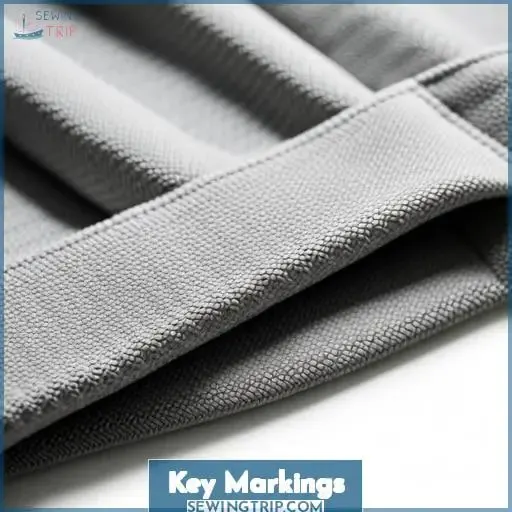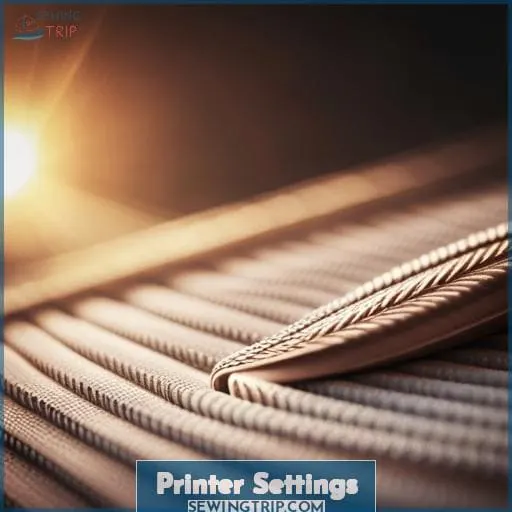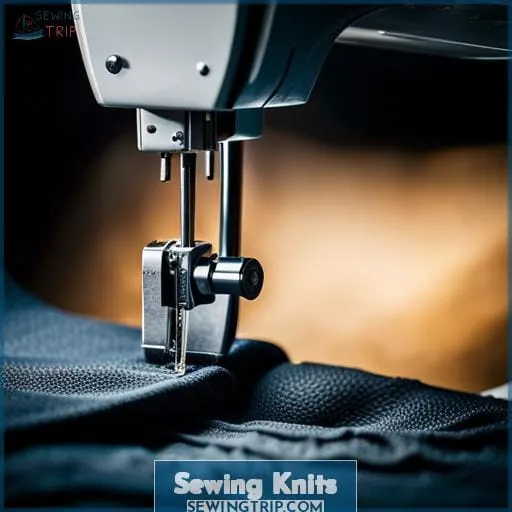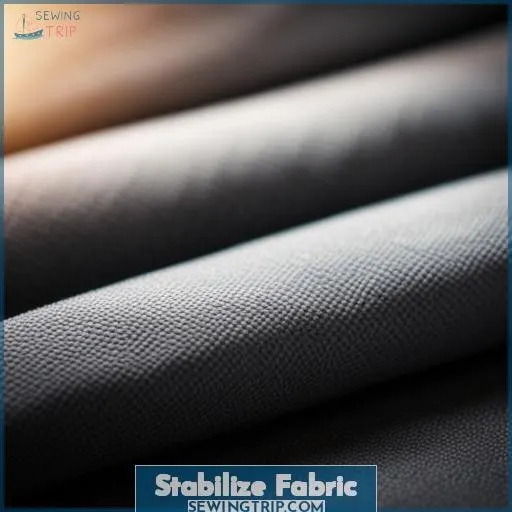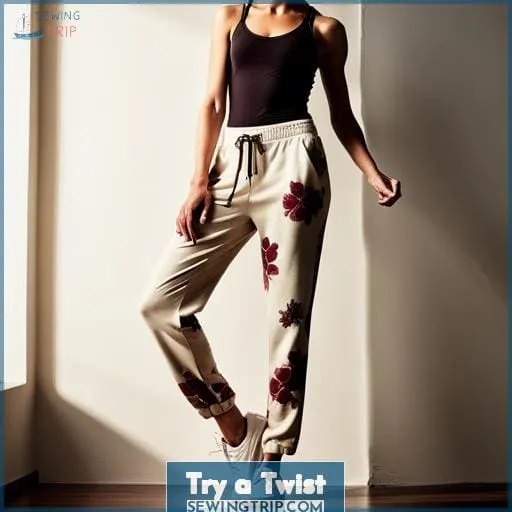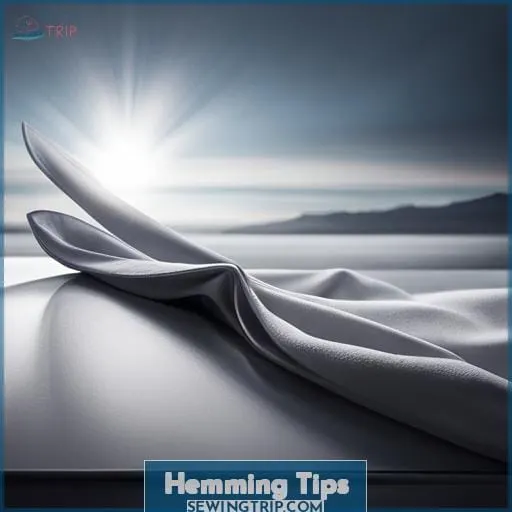This site is supported by our readers. We may earn a commission, at no cost to you, if you purchase through links.
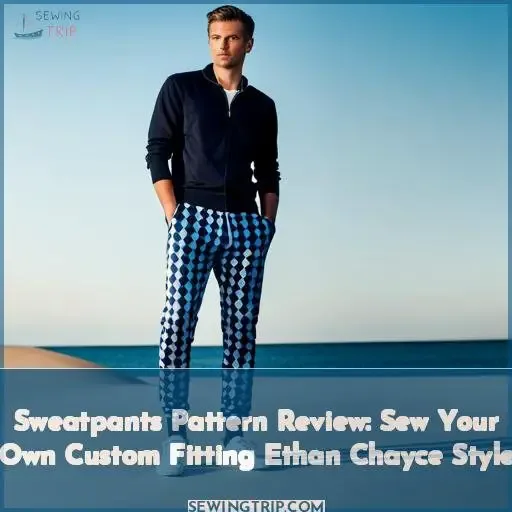
First, learn key details about the sweatpants pattern, including recommended fabrics, necessary tools, and essential markings.
Next, get tips to master sewing knits, stabilize fabric, add twists, and properly hem.
With a pattern specifically designed to fit your body, using the right techniques for stretchy knits is crucial.
Follow the step-by-step advice to sew custom sweatpants that actually fit.
Soon you’ll be rocking Ethan Chayce style pants you made yourself. Feel that sense of accomplishment and comfort every time you wear them.
Table Of Contents
Key Takeaways
- Designed for knits with stretch, use appropriate tools like jersey needles and a walking foot.
- Markings guide construction, so take care when transferring to the fabric and aligning the grains.
- Add visual interest with topstitching and twins, managing the stretch as you sew.
- This pattern works for beginners to practice key skills like hemming knits and stitching stretch fabrics.
Pattern Details
For topstitching those sweatpants, you’ll need that German-made stretch twin and some of the longer pins to handle the knits without frustration. When sewing stretch fabrics like knits, choose a machine with stretch stitch options.
Test different lengths and widths on scraps to find the best stretch stitch for your fabric. Stretch twin needles and ballpoint pins glide smoothly through knits without distorting seams or holes. Pin generously, easing the fabric to prevent puckers. Remember to change the needle frequently to avoid skipped stitches on the stretchy material.
Recommended Fabrics
Choose needles and threads designed specifically for stretch fabrics. Opt for stretch, ballpoint, or jersey needles that slide smoothly without piercing or distorting the knit’s loops. A walking foot can help feed the layers evenly. Try using stretch threads like woolly nylon in the bobbin or lightweight polyester thread on top.
With these specialized tools, you’ll be able to sew knits and spandex blends with no skipped stitches, puckered seams, or wavy hems.
Necessary Tools
Opt for specialty Schmetz Stretch Twin Needles and long Dritz Ball Point Pins when beginning to sew Brett sweatpants from Ethan Chayce to handle the thickness and stretch. Try ethical White Thread, though pricier, for an eco-friendly option. Needles designed to pierce without distorting knit loops, pins that grip many fabric layers, and quality thread will help you avoid skipped stitches and puckered seams when constructing these athleisure pants.
Carefully selecting the proper needles, pins, and thread ensures sewing success.
Needles
Don’t let skipped stitches or puckered seams get you down. Check out the Schmetz Stretch Twins for smooth sewing on knits and spandex with nary a wave in sight.
- Designed specifically for stretch fabrics, they prevent skipped stitches and puckering.
- They create professional-looking seams.
Stick to needles made for stretching and bending without distorting knit loops. The right tools are key to skipping frustrating mistakes.
Pins
Get precision piercing with Dritz long ball point pins. Select the extra long pins to smoothly pin multiple layers of fabric for indie sewing patterns. The nickel plated steel pins keep cut lines exact when pinning different fabric pieces together before the sewing process.
Thread
Stitch carefully using White Thread’s organic cotton for your handmade indie patterns. This natural, fair trade thread provides an ecologically-friendly option for stretch fabrics, though more expensive and limited in color options.
Key Markings
When sewing the Brett sweatpants from Ethan Chayce, pay close attention to the grainlines, fold lines, and stitching lines marked on the pattern pieces. Following the grainlines will help the pants drape properly; fold lines indicate where to fold the fabric before cutting; and stitching lines show where to sew seams.
Carefully tracing these key markings from the pattern onto your fabric will ensure the pants are constructed correctly. Always transfer all pattern markings to your fabric, as they provide essential sewing guidance.
Grainlines
You’ll want to pay attention to grainlines when cutting your sweatpant fabric or the finished garment may twist and distort. Matching the grainline arrows printed on each pattern piece to the lengthwise and crosswise grain of your fabric is crucial for getting the stretch and drape just right.
Skipping this step could make your sweatpants misshapen and uncomfortable to wear.
Fold Lines
Gotta follow those fold lines printed on the pattern pieces when cutting or you’ll end up with uneven, crooked seams.
- Align fold line arrows parallel to fabric selvage.
- Ensure pattern pieces lie flat when cutting.
- Secure with pins along fold lines.
Fold lines guide proper fabric grain alignment for drafted garment pieces. Skipping this step distorts the intended drape and flow of the finished sweatpants.
Stitching Lines
Following the stitching lines keeps those seams straight as an arrow. When sewing stretchy fabrics like knits, overlooking printed stitch guides results in wavy seams. Using a roller or walking presser foot is your best option for keeping the fabric taut.
Avoid regular pins—they leave permanent holes. Tracing stitching lines with fabric marker beforehand also helps you sew precise seams.
Printer Settings
When printing the Brett sweatpants pattern, set your printer to actual size with no scaling to get an accurate printout. Be sure to select 100% scale and print actual size in your printer settings. Choosing fit to page or any scaling options will distort the pattern pieces.
Print a test page first to confirm your printer prints true to size. Use 8.5 x 11 printer paper for easier taping together. Align pattern pieces precisely along the marked grainlines, cut lines, notches, fold lines, and dart lines.
Following these key markings exactly while cutting and sewing will guarantee the finished pants match the designer’s intent. Take your time tracing over the faint lines before cutting your fabric. Correctly scaled and sharply defined pattern pieces are vital for properly constructing the sweatpants.
Sewing Knits
Now that you’ve printed and assembled the pattern pieces, it’s time to cut and sew the sweatpant fabrics.
- Use a stretch or lightning bolt stitch on seams and hems so they can stretch with the fabric.
- Cut fabric pieces following the pattern’s stretch grain for optimal stretch.
- Opt for cotton thread over polyester which can cut knits when sewn tightly.
- Finish seams and hems with a zig zag or overlock stitch to prevent unraveling.
Following specialty techniques for handling super stretchy fabrics allows the finished sweatpants to flex and move with your body while maintaining a clean, professional look. Take it slow and don’t pull or stretch the fabric pieces when sewing. With thoughtful preparation and patience, you’ll craft the perfect pair of athletic sweatpants.
Stabilize Fabric
To prevent the super stretchy sweatpant fabric from warping, spray some temporary fabric stabilizer on the back before cutting your pieces. Align the pattern’s grainlines, notches, fold lines, and stitching lines to prevent distortion.
Lightly fuse fusible tricot interfacing to the wrong side of fabric pieces as the pattern guidelines direct. This supports the knit fabric’s structure when cutting and sewing, preventing necklines, hems, and seams from stretching out.
Carefully follow all markings when cutting and constructing to ensure properly fitting sweatpants that move with your body.
Try a Twist
Use an unexpected twist on the cuffs and waistband for some extra flair. Add topstitch detailing for interest and definition by stitching parallel rows 1/8-inch apart around the cuffs and waistband using regular polyester thread.
Consider a contrasting thread color that complements the sweatpant fabric. Mark evenly spaced rows on the right side before topstitching and align the fabric’s straight grain under the presser foot to keep lines straight.
Lengthen the stitch and reduce tension slightly when sewing over multiple thicknesses. Press each row flat as you go. Ballpoint pins can help control the stretchy fabrics when aligning the rows. With creative touches like contrast stitching, you can personalize a basic sweatpant pattern.
Hemming Tips
Before hemming, take time selecting the right needles for handling knits and stretch fabrics so the stitches glide smoothly without skipping, and go with longer pins that can penetrate multiple thick layers.
- Mark hemlines with chalk, accounting for wear and shrinkage.
- Check grainlines, match notches, align symbols.
- Measure and trim excess fabric evenly.
When preparing to hem knit pants, invest time upfront in steps like selecting quality needles and marking properly. This helps achieve a precise, pucker-free hem that maintains the integrity of the fabric.
Anticipating shrinkage and matching pattern markings ensures the hem hangs evenly.
Share Your Make
Show us your latest creation featuring those stretch twin needles for skip-free seaming. With stretchy fabric, take extra care aligning grain lines and markings before stitching. Check dart markings and notches, pinning pattern pieces methodically. Mind the stitching lines, gently easing the fabric as you join seams.
Match symbols precisely, finger pressing as you go. Though preparing knits takes focus, proper precision prevents distortion. Share your makes showcasing smooth twin needle hems and seams. We want to see how those specialty needles perform on your stretch projects.
Frequently Asked Questions (FAQs)
Do you need an overlock/serger machine to sew these sweatpants?
You don’t absolutely need a serger to sew these sweats, but it certainly eases the process. A good old sewing machine can still whip up a fine pair, just take it slowly and use quality thread to avoid any wardrobe malfunctions.
What length are the finished sweatpants?
You’ll love how the finished sweatpants hit at just the right spot on your ankle for a flattering, comfortable fit. I’d estimate the inseam measures about 27 inches, though you can easily adjust the length by folding up or hemming the cuffs.
Do the pants have working drawstrings?
Yes, the sweatpants have fully functional drawstrings like a hug around your waist. The elastic waistband and adjustable drawcords let you customize the fit for all-day comfort. The relaxed style provides freedom of movement while the tapered leg adds subtle shaping.
Is the sizing accurate compared to ready-to-wear clothes?
Yes, the sizing runs true. For a comfortable relaxed fit, order your normal size. If you prefer a slimmer silhouette, consider sizing down. The elastic waistband also provides flexibility for an accurate, personalized fit.
How easy is it for a beginner sewer to make this pattern?
Overall, this pattern has clear instructions and simple construction suitable for a beginner. The elastic waistband and tapered leg may challenge some, but with patience a novice can achieve a polished look.
Let this stylish sweatpant pattern build your confidence as you master key techniques.
Conclusion
At the finish line, analyze your hand-sewn creation. Like a marathon runner, reflect back on the journey. Stitch by stitch, you crafted custom sweatpants. Though daunting at first, Ethan Chayce’s pattern empowered you.
Armed with ballpoint pins and twin stretch needles, you tackled tricky knits. Now swagger in style you personalized. Share your make and inspire others. With practice, your sewing skills will evolve. Yet never lose your beginner’s spirit, thirsty to learn more. For each project gifts lessons, strengthening your abilities.
Keep challenging yourself with patterns new, fabrics bold. The sewing road beckons; adventures await.

